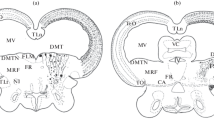Abstract
After tail amputation in urodele amphibians, dramatic changes appear in the spinal cord rostral to the amputation level. Transection induces a proliferation response in cells lining the ependymal canal, giving rise to an ependymal tube in which neurogenesis occurs. Using the thymidine analog bromodeoxyuridine (BrdU) in short- and long-term labeling of cells undergoing DNA synthesis (S phase of the cell cycle), specific cell markers, and cell cultures, we show that neurons derive from the proliferative ependymal layer of the ependymal tube.
Similar content being viewed by others
Author information
Authors and Affiliations
Additional information
Received: 30 November 1998 / Accepted: 22 December 1998
Rights and permissions
About this article
Cite this article
Benraiss, A., Arsanto, J., Coulon, J. et al. Neurogenesis during caudal spinal cord regeneration in adult newts. Dev Gene Evol 209, 363–369 (1999). https://doi.org/10.1007/s004270050265
Issue Date:
DOI: https://doi.org/10.1007/s004270050265




